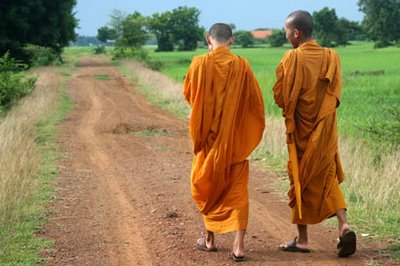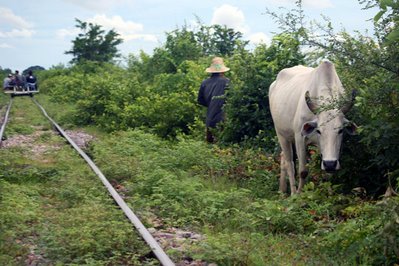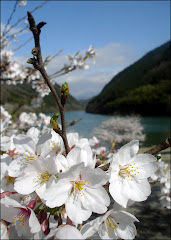
Cambodia's Rice Bowl: Lush rice fields (during the rainy season) stretch as far as the eye can see from the top of Mount Sampoa, a rewarding view of the Cambodian countryside and welcomed rest after scaling 600+ steps.

August 2006
On what I thought could possibly be my last day in Siem Reap (I'm never sure about these things. Who knows what would happen, who I may meet, what unforseeable adventure might come along?) I headed to Angkor Wat to enjoy the wonderful light fade over the ancient stones for one last sunset. As I mozied up the causeway admiring the peaks of Mt. Meru framed by reflective ponds and sugar palms, I noticed the tangerine robes of two monks, sheltering their squinting eyes as they walked into the sunlight. After meeting the friendly monks in Phnom Pehn, I couldn't help but smile as they drew near. "Hello!" They smiled, veering slightly from their course to meet me. They began by asking me where I was from, how long I had been in Cambodia- the usual conversation starters.
"How about you? Where are you from?"
"We're from Cambodia, of course!" The older, shorter one laughed.
I giggled. "I know! I mean, where in Cambodia?"
"Oh! (Laughing. I love the way Cambodians laugh.) We're just visiting from our pagoda in Battambang."
"Really? Battambang?" I asked excitedly. I was thinking about heading to Battambang myself, and this seemed like a sign. "I'm going to Battambang, too."
The monks asked me to come visit them at their pagoda if I had a chance. They gave me their address and names, wished me good luck and success, and disappeared through the shadowy stone gate.
When I returned to my guesthouse, I booked a boat trip to Battambang.

These two cutnesses kept me occupied on the 7 hour boat ride from Siem Reap to Battambang, Cambodia's second biggest city. We cruised the watery alley ways of a few floating villages and dangerously narrow paths through submerged forests, swallowed by the swollen waters of rainy season. The passages were so narrow that branches clawed through the windows, whippping and scratching unsuspecting passangers, and almost tearing the cutains right out of the boat. Weary travelers spent most of the trip hunched over, hugging their knees, bracing themselves for the fury of the sunken ents.
After checking into the Chaaya Hotel with a Finnish girl I had befriended on the boat, I took a very cold shower and collapsed on the bed. "I'm going to smoking pot," she told me nonchalantly. "Would you like to come?"
"I'm sorry," I said, thinking I had heard her wrong. "You're going to what?"
"Smoking pot," she said, pausing for a moment before bursting into laughter. "The Smoking Pot! Not smoking pot! It's a restaurant quite near here. I want to sign up for a cooking lesson. The Smoking Pot is the name!"
We laughed as we headed for The Smoking Pot, sharing stories and adventures over delicious Chaa Kreung and fish Amok (Cambodia's national dish) as we slurpped down deliciously fresh fruit Tukalok (smoothies). I told her about the monks I had met first in Phnom Pehn, and then Siem Reap, and asked if she would be interested in walking down to their pagoda to meet them. After the time she had spent in Thailand, she seemed very suprised that monks would be so friendly with foreigners, especially women, but she was very excited. After finishing our final fruit smoothies, she pulled out her LP, located the pagoda they had neatly written in my notebook, and led the way.
It was late afternoon, and I was a little shy about walking into the quite temple grounds. The sun was begining to fade, and there was no one to be seen near the gate. I wondered what the monks and nuns would think when they saw two foreign girls stumble into their sanctuary, wandering around aimlessly, but soon after we crossed the threshold a group of young monks appeared in the distance and seemed to notice us immediately. "Hello!" One of them cried out, smiling and laughing, leading the others in our direction.
"Hello!" We called back, Heidi, as any normal person might, I, with that strange semi-bow thing I've picked up in Japan. The friendly monk, dressed in a deep, dignified crimson robe I had not yet seen before introduced himself as Ratha and began to ask us questions about where we were from and our time in Cambodia. As we stood there talking, many of the monks who were returning from class or had heard us laughing came out to join us. Eventually we sat beneath the eaves of the temple library,asking an answering each others questions and telling jokes, laughing like old friends.
"How long will you be in Battambang?" Ratha asked.
"Just two days," Heidi answered decidedly. I, of course, was far less sure.
"What are you going to do tomorrow?"
He looked at us, and we looked at each other."Well, we want to see the countryside," Heidi finally answered, "And ride the bamboo train!" I threw in enthusiastically.
"Okay!" Ratha exclaimed. "If you like, we can take you to the countryside and show you the temples. I studied English and tourism so I can be a good guide for you! I know all about the history and the lives of the people."
"Really?" We were both ecstatic. That sounded way better than dealing with the motodups back at the hotel. "Can you do that? Are you free?"
"Sure! Don't worry. Many times when foreigners come here and have a free time, we can show them the countryside and help them to understand Cambodia. Okay. So, let's meet here tomorrow at 9. Okay?"
"So much for my smoking pot class," Heidi whispered under her breath.
The sun had long since set and the monks were worried about us walking back to the hotel. They tried to convince us to take the temple motos for free or catch a tuk-tuk, but it really wasn't too far and we felt safe together. "Its not good for girls to walk alone at night." Ratha said with a worried look.
"That's OK. We're tough, and we're not alone."
"Foreign women are so brave," he said as we walked out the gates. "See you tomorrow!"
 Transalation: Shakai no mado: Social window, society's window.
Transalation: Shakai no mado: Social window, society's window. 

 Home-made roadtrip-commemorative purikkura!
Home-made roadtrip-commemorative purikkura! Who is that hooded slurper? What excellent chopstick form!
Who is that hooded slurper? What excellent chopstick form!





 Concentrate! I`m showing off my ability to count in Khmer.
Concentrate! I`m showing off my ability to count in Khmer.



 August 28, 2006: My last lunch with the monks.
August 28, 2006: My last lunch with the monks.
 Wrong!
Wrong!

 Ratha in his hammock.
Ratha in his hammock.
 Yeay Vouy.
Yeay Vouy. The girls and I. I know they don't look thrilled, but they actually asked to take a picture together so that I wouldn't forget them.
The girls and I. I know they don't look thrilled, but they actually asked to take a picture together so that I wouldn't forget them.


 August 2006, Battambang Day 3: Kosul, Ratha, and my fellow passengers on Battambang`s Bamboo train.
August 2006, Battambang Day 3: Kosul, Ratha, and my fellow passengers on Battambang`s Bamboo train. A young conductor pulling into the "station".
A young conductor pulling into the "station". Ratha and Kosul enjoy the ride.
Ratha and Kosul enjoy the ride. Another bamboo train chucking along in our general direction.
Another bamboo train chucking along in our general direction. Having disembled our train so that the other might pass, I note that we are being watched. A spy for the anti-norry authorities, perhaps?
Having disembled our train so that the other might pass, I note that we are being watched. A spy for the anti-norry authorities, perhaps?
 Ratha and Sammuth share a laugh about my fortune, which they translated for me: "Soon I will find the love of my life and be married within two years." This after the first one warned me to be careful about traveling. Have I mentioned the moto-burn/toothpaste incident?
Ratha and Sammuth share a laugh about my fortune, which they translated for me: "Soon I will find the love of my life and be married within two years." This after the first one warned me to be careful about traveling. Have I mentioned the moto-burn/toothpaste incident?


 Cambodia's Rice Bowl: Lush rice fields (during the rainy season) stretch as far as the eye can see from the top of Mount Sampoa, a rewarding view of the Cambodian countryside and welcomed rest after scaling 600+ steps.
Cambodia's Rice Bowl: Lush rice fields (during the rainy season) stretch as far as the eye can see from the top of Mount Sampoa, a rewarding view of the Cambodian countryside and welcomed rest after scaling 600+ steps.
 These two cutnesses kept me occupied on the 7 hour boat ride from Siem Reap to Battambang, Cambodia's second biggest city. We cruised the watery alley ways of a few floating villages and dangerously narrow paths through submerged forests, swallowed by the swollen waters of rainy season. The passages were so narrow that branches clawed through the windows, whippping and scratching unsuspecting passangers, and almost tearing the cutains right out of the boat. Weary travelers spent most of the trip hunched over, hugging their knees, bracing themselves for the fury of the sunken ents.
These two cutnesses kept me occupied on the 7 hour boat ride from Siem Reap to Battambang, Cambodia's second biggest city. We cruised the watery alley ways of a few floating villages and dangerously narrow paths through submerged forests, swallowed by the swollen waters of rainy season. The passages were so narrow that branches clawed through the windows, whippping and scratching unsuspecting passangers, and almost tearing the cutains right out of the boat. Weary travelers spent most of the trip hunched over, hugging their knees, bracing themselves for the fury of the sunken ents. 


